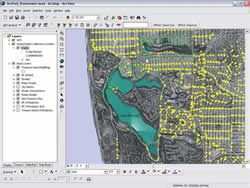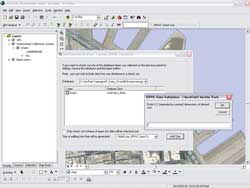Heading Off Water Pollution
Continued...
The checkout process was further enhanced by customizing GPS Analyst to create an even smoother and more efficient workflow. "Safeguards are in place to make sure that all of the data layers that need to be checked out for the workday are actually checked out," said David Marley, VESTRA senior GIS applications developer. "There are also checks in place to ensure the coordinate system is set and that the data is, in fact, GPS enabled."
One example of a crucial data layer is the intersection layer. This layer allows workers to enter two street names and quickly zoom into a map that contains all storm drains located in the vicinity of that intersection. In urban canyon areas where satellite signals are limited, this capability is extremely useful as it allows workers to quickly locate the drain, collect the data, and move on to the next drain.
A field crew usually takes the data layers that it needs to find the catch basins and reference surrounding features using street centerlines, parcel maps, and black-and-white aerial imagery. The data steward need only define the extent of a geographic area on the computer screen and the GPS Analyst extension automatically cuts out all selected GIS reference data layers for those specific areas.
Once in the field, the field technician uses a GPS receiver to collect the location of a newly installed curb marker, then opens a customized ArcPad applet on the handheld's screen to input a description of the drain or basin condition. The technician takes careful note of any repair or cleaning needed. When available, field crews rely on the Federal Aviation Administration's Wide-Area Augmentation System (WAAS) for real-time differential correction. The GPScorrect extension automatically acquires the satellite data necessary for postprocessing both for WAAS real-time differential and uncorrected (autonomous) data.
When the field crews return to the CSD office, the data steward downloads collected location and attribute data from the handhelds onto a desktop computer. The steward opens the GPS Analyst extension in ArcGIS and verifies the collected data. The newly collected field data is checked back into the working copy of the personal geodatabase. Next, the field data is postprocessed for higher horizontal accuracy. The GPS Analyst extension logs into the Internet to search for and access any available differential correction data from a local GPS base station.
Back in the office, the software automatically performs the postprocessing needed to achieve the submeter location accuracy required by SFPUC by comparing GPS field data with base station data and spatially adjusting it. The edited and processed data is uploaded to the enterprise geodatabase where work orders are generated for the maintenance on catch basins that were flagged in the field for repair or cleaning.
 |
| Accurate location coordinates had never been mapped for the catch basins and storm drains. By including this information in the GIS, the city now has a much easier time finding the exact storm drain where illegal dumping has been reported. |
"The checking in and correction of the data are greatly streamlined by GPS Analyst," said Marley. "This is a huge time saver for the data steward. Having access to historical GPS metadata viewed within the GPS Analyst extension will prove to be a very valuable tool for the organization, over time."
Yet another key piece to the data collection portion of this project is the customization of ArcPad. "Our main goal was to ensure a successful and productive field session for every SFPUC field worker and make sure the information was being captured in a standard way," Marley said. "Ease of use was another important factor."
Customized data collection forms and toolbars were created in ArcPad. "We wanted to make the data collection process consistent for each and every trip to the field," added Marley. "We also wanted to avoid having the field-workers perform repetitive tasks, which take a lot of time. Instead, the worker just has to enter his or her name once and it automatically populates with the department name, date, and time for each field data collection session conducted."
The best thing about the customization is that it will work in any situation says Marley. "This is not just for water pollution management, but it is meant to fit into any workflow and to work for all of their projects and tasks," he said. Indeed, two other organizations within SFPUC have already made investments in acquiring field and office software and staff training. They will take advantage of the ArcPad customization. In the big picture, mobile GIS technology affords them the tools to move away from capturing and maintaining data inefficiently on paper to a more cost-effective and accurate digital format.
Improving Efficiency, Reducing Pollution
With updated storm drain and catch basin locations in the geodatabase, GIS plays multiple roles in the water pollution prevention program. As telephone calls are received from citizens reporting illicit dumping, GIS can be used to cross-reference the street address or intersection information supplied by the caller and pinpoint the precise basin involved in the infraction. A maintenance crew can be quickly dispatched to clean contaminants from the sump.
 |
| Each department selected a data steward who is solely responsible for managing the mobile GIS data before it goes to the field and after field GPS data collection has occurred. |
However, the activity won't stop there. "The GIS allows us to display the locations of incoming calls on a city map," said Harrison. "If the display indicates a concentration of infractions from a specific neighborhood, we will send personnel into that area with door hangers and flyers to educate those residents on the importance of keeping pollutants out of the storm drains."
The city also expects to use the GIS mapping functions to identify areas of the city with the most reports of illegal dumping. If the map shows that those neighborhoods have not yet been targeted for curb marking, they will move to the top of the installation list.
Harrison added that SFPUC is also ready to use the curb marker GIS layer for tactical purposes in the event of a major spill. For instance, if a tanker truck spilled thousands of gallons of oil onto a city street, GIS would be used to determine which catch basins and storm drains might be involved. Crews could be dispatched to make sure sumps don't back up, and technicians could trace drainage routes from the scene to a specific water treatment plant and notify personnel at that plant to take appropriate action against the incoming oil.
To date, SFPUC has marked and mapped 10 percent of the city's catch basins and storm drains. The commission estimates the entire program will be completed in about three years. In the meantime, SFPUC plans to expand the use of mobile GIS to several other departments so that more accurate map layers can be created for the city's many utility assets. For more information on this program, contact Lily Dryden at ldryden@sfwater.org.
About the Author
Lily Dryden has been the enterprise GIS coordinator for the San Francisco Public Utilities Commission (SFPUC) for the past five years. In this position. she has implemented GIS on the enterprise level as well as in SFPUC programs, facilitated numerous workshops, and conducted training. Previously, she worked for Computer Sciences Corporation, Applied Technology Associates, and Science Applications International Corporation (SAIC) as a GIS specialist and for the City and County of San Francisco Department of Public Works as a GIS programmer analyst. She holds a bachelor's degree in geography from San Francisco State University and an environmental management certificate from the University of California, Berkeley Extension.
|